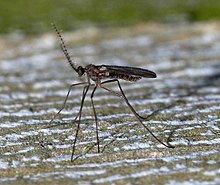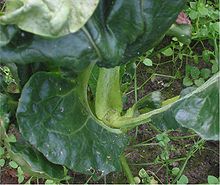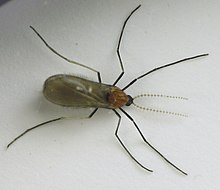Cecidomyiidae
| Cecidomyiidae Temporal range: Late Jurassic–Recent
PreꞒ
Ꞓ
O
S
D
C
P
T
J
K
Pg
N
| |
|---|---|

| |
| Scientific classification | |
| Kingdom: | Animalia |
| Phylum: | Arthropoda |
| Class: | Insecta |
| Order: | Diptera |
| Suborder: | Nematocera |
| Infraorder: | Bibionomorpha |
| Superfamily: | Sciaroidea |
| Family: | Cecidomyiidae Newman, 1835 |
| Subfamilies | |
| |
| Synonyms | |
| |

Cecidomyiidae is a family of flies known as gall midges or gall gnats. As the name implies, the larvae of most gall midges feed within plant tissue, creating abnormal plant growths called galls. Cecidomyiidae are very fragile small insects usually only 2–3 mm (0.079–0.118 in) in length; many are less than 1 mm (0.039 in) long. They are characterised by hairy wings, unusual in the order Diptera, and have long antennae. Some Cecidomyiids are also known for the strange phenomenon of paedogenesis in which the larval stage reproduces without maturing first.[4][5] In some species, the daughter larvae consume the mother, while in others, reproduction occurs later on in the egg or pupa.[5]
More than 6,000 species and 783 genera are described worldwide, but since 1,100 are from well-studied North America, this is certainly an underestimate,[6] and a recent DNA barcoding study estimated the fauna of Canada alone to be in excess of 16,000 species, hinting at a staggering global count of over 1 million cecidomyiid species that have yet to be described, which would make it the most speciose single family in the entire animal kingdom.[7] A second study performed in Costa Rica also found Cecidomyiidae to be the most diverse family of flies, supporting this assertion.[8]


Description[]
Cecidomyiidae are minute to small (0.5–3.0 mm), rarely larger (up to 8 mm, wing length 15 mm) flies with a delicate appearance. Except for a few genera with reduced wings, the eyes are holoptic. The mouthparts are reduced. Cecidomyiid antennae are notably long, with 12–14 segments, (sometimes fewer and up to 40 in some genera). The antennal segments either consist of a basal thickening and petiole or they are binodal, with a proximal node, an intermediate petiole and a distal node. Basal, medial, and apical whorls of hairs occur on the antennal segments. In some species, whorls of loop-shaped sensory filaments are also found, the basal or medial one sometimes being reduced. Some gall flies have only one (basal) whorl of hairs on the antennal segments, and the sensoria (transparent sensory appendages) differ in size and shape. The filaments are thread-like in the Porricondylinae and in all the Cecidomyiinae and take the form of long loops in the supertribe Cecidomyiidi). Ocelli are present only in the . The wings are usually clear, rarely patterned. The wing bears microtrichia, often as scales, and some species have macrotrichia. The number of longitudinal veins is reduced. Only veins R1, R4+5, M3+4 and Cu1 are well developed in most species. The medial veins M1 and M2 are developed only in primitive groups, and the costa usually has a break just beyond vein R5. The legs are long and slender, without apical bristles.

Catochini wing veins

Cecidomyiinae wing veins

Lasiopterini wing veins

Lestremiini wing veins

Micromyini and Peromyiini wing veins

Porricondylinae (most) wing veins

Winnertziini wing veins
The genitalia of males consist of gonocoxites, gonostyles, aedeagus, and tergites 9 and 10. Lower (in the evolutionary sense) gall flies often have sclerotized parameres and a more or less transparent plate (the tegmen) located above theaedeagus-the tegmen. In higher gall flies, the parameres and tegmen are not developed. In these, instead, close to the aedeagus, is a triangular basal outgrowth of the gonocoxites called the gonosterna. Supporting structures called apodema are located near the base of the genitalia in males; these are often equipped with two outgrowths. The ovipositor is short, lamelliform, or long, mobile, and in some species, acicular.
The larva is peripneustic. The head is tiny, cone-shaped, and has two posterolateral extensions. The mouthparts are reduced, with minute styliform mandibles. The relatively prominent antennae are two-segmented. Integumental setae or papillae are important in taxonomy since they are constant in number within groups. The prothorax has sclerotized sternal spatula (most). The anus is terminal in the Lestremiinae and paedogenetic in the Porricondylinae and ventral in other groups. The pupa is exarate (in a few species it is enclosed within the last instar larval integument). The anterior spiracle and anterior angle of antennal bases is prominent (most).[9][10]


As a pest or biological control[]
Many species are economically significant, especially the Hessian fly, a wheat pest, as the galls cause severe damage. Other important pests of this family are the wheat blossom midge Sitodiplosis mosellana, the Asian rice gall midge (Orseolia oryzae) and the African rice gall midge O. oryzivora. The millet grain midge (Geromyia penniseti), sorghum midge (Contarinia sorghicola), and African rice gall midge (Orseolia oryzivora) attack grain crops such as pearl millet in Mali and other countries of the Sahel in West Africa.[11]
Other pests are the (Dasyneura coffeae), , (Asphondylia yushimai) (Thecodiplosis japonensis), the lentil flower midge (), the lucerne flower midge (), and the alfalfa sprout midge () on the Leguminosae; the (Obolodiplosis robiniae), the swede midge (Contarinia nasturtii), and the brassica pod midge (Dasineura brassicae) on the Cruciferae; the pear midge () and the raspberry cane midge () on fruit crops; on ornamental figs, and the rosette gall midge (Rhopalomyia solidaginis) on goldenrod stalks, Porricondylini spp. on Citrus, spp. on sweet potato, yam, ginger, garlic, onions, taro tubers, and potato, spp., spp., and Aphidoletes spp. on oranges, and spp. on limes.[12][13][14]
Parasitoids hosted by the Cecidomyiidae, thereby limiting the gall midge population include the Braconidae (Opiinae, Euphorinae) and chalcidoid wasps in the families Eurytomidae, Eulophidae, Torymidae, Pteromalidae, Eupelmidae, Trichogrammatidae, and Aphelinidae. All contain species which are actual or potential biological agents.
A large number of gall midge species are natural enemies of other crop pests. Their larvae are predatory, and some are reported as parasitic. The most common prey are aphids and spider mites, followed by scale insects, then other small prey such as whiteflies and thrips, which eat the eggs of other insects or mites. As the larvae are incapable of moving considerable distances, a substantial population of prey must be present before the adults lay eggs, and the Cecidiomyiidae are most frequently seen during pest outbreaks. One species, Aphidoletes aphidimyza, is an important component of biological control programs for greenhouse crops and is widely sold in the United States. In South Africa, Dasineura rubiformis has been deployed against invasive Australian Acacia species.
References[]
- ^ Gagné, Raymond; Jaschhof, Mathias (2017). "A Catalog of the Cecidomyiidae (Diptera) of the World, Fourth Edition" (PDF). Agricultural Research Service, US Department of Agriculture. Retrieved 2018-04-29.
- ^ Mathias Jaschhof (2016). "A review of world Diallactiini (Diptera, Cecidomyiidae, Winnertziinae), with the description of six new genera and seventeen new species". doi:10.11646/zootaxa.4127.2.1. Cite journal requires
|journal=(help) - ^ "University of California, Riverside". Archived from the original on 2015-09-24. Retrieved 2013-01-04.
- ^ Gagne, R.J.; Jaschhof, M. (2017). A Catalog of the Cecidomyiidae (Diptera) of the World. Fourth Edition (PDF). Systematic Entomology Laboratory, Agricultural Research Service, U.S. Dept. of Agriculture. ISBN 978-0-9863941-2-6.
- ^ Jump up to: a b Wyatt, I.J. 1961. Pupal paedogenesis in the Cecidomyiidae (Diptera).–I. Proceedings of the Royal Entomological Society of London (A) 36: 133–143.
- ^ Raymond J Gagné , 2004 A catalog of the Cecidomyiidae (Diptera) of the world Entomological Society of Washington Issue 25
- ^ Hebert PDN, Ratnasingham S, Zakharov EV, et al. (2016) Counting animal species with DNA barcodes: Canadian insects. Philosophical Transactions of the Royal Society B: Biological Sciences. 2016;371(1702):2015.0333, doi:10.1098/rstb.2015.0333
- ^ Borkent A, et al. Remarkable fly (Diptera) diversity in a patch of Costa Rican cloud forest: Why inventory is a vital science. Zootaxa. 2018 Mar 27;4402(1):53-90. doi: 10.11646/zootaxa.4402.1.3. PMID: 29690278.
- ^ Gagné, R. J. 1981. Cecidomyiidae. In: McAlpine, J. F. et al. (eds.), Manual of Nearctic Diptera. Vol. 1. Research Branch, Agriculture, Canada, Ottawa. pp. 257–292. download here Archived 2013-12-01 at the Wayback Machine
- ^ Mamaev, B.M. Family Cecidomyiidae in Bei-Bienko, G. Ya, 1988 Keys to the insects of the European Part of the USSR Volume 5 (Diptera) Part 2 English edition.Keys to Palaearctic species but now needs revision.
- ^ Heath, Jeffrey. "Guide to insects, arthropods, and molluscs of northern Dogon country".
- ^ Darvas, B., Skuhravá, M., Andersen, A., 2000, Agricultural dipteran pests of the Palaearctic Region. In: Papp, L., Darvas, B. (Eds.). Contributions to a Manual of Palaearctic Diptera with Special Reference to Flies of Economic Importance. Science Herald, Budapest, 565–649.
- ^ Dennis S. Hill, 1987 Agricultural insect pests of temperate regions and their control Cambridge [Cambridgeshire] ; New York : Cambridge University Press, 1987.ISBN 0521240131
- ^ Dennis S Hill 1987 Agricultural Insect Pests of tropics and their control Cambridge. University Press , New York ISBN 9780521294416
Further reading[]
Economic[]
- Barnes, H.F. 1946a. Gall midges of economic importance. Vol. I: gall midges of root and vegetable crops. Crosby Lockwood & Son Ltd., London.
- Barnes, H.F. 1946b. Gall midges of economic importance. Vol. II: gall midges of fodder crops. Crosby Lockwood & Son Ltd., London.
- Barnes, H.F. 1948a. Gall midges of economic importance. Vol. III: gall midges of fruit. Crosby Lockwood & Son Ltd., London.
- Barnes, H.F. 1948b. Gall midges of economic importance. Vol. IV: gall midges of ornamental plants and shrubs. Crosby Lockwood & Son Ltd., London.
- Barnes, H.F. 1949. Gall midges of economic importance. Vol. VI: gall midges of miscellaneous crops. Crosby Lockwood & Son Ltd., London.
- Barnes, H.F. 1951. Gall midges of economic importance. Vol. V: gall midges of trees. Crosby Lockwood & Son Ltd., London.
- Barnes, H.F. 1956. Gall midges of economic importance. Vol. VII: gall midges of cereal crops. Crosby Lockwood & Son Ltd., London. 261 p.
- Nijveldt, W. 1969. Gall midges of economic importance. VIII: gall midges—miscellaneous. Crosby, Lockwood & Son Ltd., London
- Jahn, GC and B. Khiev. 2004. Gall midge in Cambodian lowland rice. pp. 71–76. In J. Benett, JS Bentur, IC Pasula, K. Krishnaiah, [eds]. New approaches to gall midge resistance in rice. Proceedings of the International Workshop, 22–24 November 1998, Hyderabad, India.
- Los Baños (Philippines): International Rice Research Institute and Indian Council of Agricultural Research. 195 p. ISBN 971-22-0198-8
- Heong, KL, YH Chen, DE Johnson, GC Jahn, M Hossain, RS Hamilton. 2005. Debate Over a GM Rice Trial in China. Letters. Science, Vol 310, Issue 5746, 231–233, 14 October 2005.
- Huang, J., Ruifa Hu, Scott Rozelle, Carl Pray. 2005. Insect-Resistant GM Rice in Farmers' Fields: Assessing Productivity and Health Effects in China. Science (29 April 2005) Vol. 308. no. 5722, pp. 688 – 690. doi:10.1126/science.1108972
Taxonomy[]
- Mohn, E. 1966–1971. Cecidomyiidae (=Itonididae). Cecidomyiinae (part). In: Lindner, E. (Ed.) Die Fliegen der Paläarktischen Region 2(2): 1–248.
- Yukawa, J. (1971) A Revision of the Japanese Gall Midges (Diptera: Cecidomyiidae). Memoirs of the Faculty of Agriculture, Kagoshima University 8: 1–203.pdf
- Kolesik, P. (2014) A review of gall midges (Diptera: Cecidomyiidae: Cecidomyiinae) of Australia and Papua New Guinea: Morphology, biology, classification and key to adults. https://doi.org/10.1111/aen.12100: 1–22. Subsequent hard copy: 2015. Austral Entomology, 54, 127–148.
External links[]
- Diptera.info images
- Family description and images at delta-intkey.com
- Cecidomyiidae
- Nematocera families
- Gall-inducing insects








